technical specifications FIAT DOBLO COMBI 2012 Owner handbook (in English)
[x] Cancel search | Manufacturer: FIAT, Model Year: 2012, Model line: DOBLO COMBI, Model: FIAT DOBLO COMBI 2012Pages: 283, PDF Size: 6.31 MB
Page 57 of 283
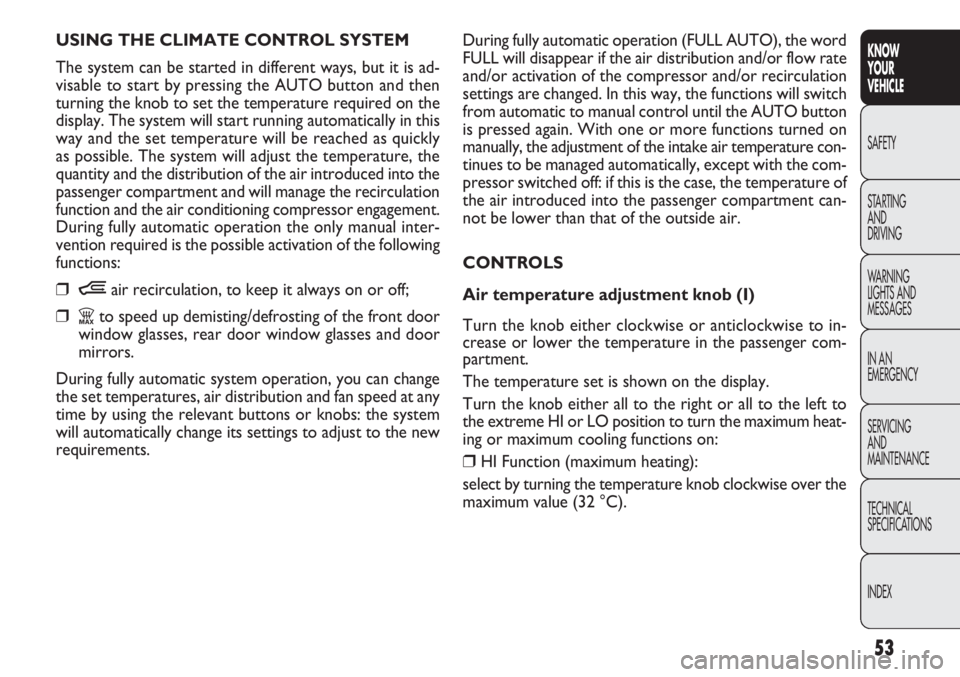
53
KNOW
YOUR
VEHICLE
SAFETY
STAR
TING
AND
DRIVING
WARNING
LIGHTS AND
MESSAGES
IN AN
EMERGENCY
SERVICING
AND
MAINTENANCE
TECHNICAL
SPECIFICATIONS
INDEX
During fully automatic operation (FULL AUTO), the word
FULL will disappear if the air distribution and/or flow rate
and/or activation of the compressor and/or recirculation
settings are changed. In this way, the functions will switch
from automatic to manual control until the AUTO button
is pressed again. With one or more functions turned on
manually, the adjustment of the intake air temperature con-
tinues to be managed automatically, except with the com-
pressor switched off: if this is the case, the temperature of
the air introduced into the passenger compartment can-
not be lower than that of the outside air.
CONTROLS
Air temperature adjustment knob (I)
Turn the knob either clockwise or anticlockwise to in-
crease or lower the temperature in the passenger com-
partment.
The temperature set is shown on the display.
Turn the knob either all to the right or all to the left to
the extreme HI or LO position to turn the maximum heat-
ing or maximum cooling functions on:
❒HI Function (maximum heating):
select by turning the temperature knob clockwise over the
maximum value (32 °C).
USING THE CLIMATE CONTROL SYSTEM
The system can be started in different ways, but it is ad-
visable to start by pressing the AUTO button and then
turning the knob to set the temperature required on the
display. The system will start running automatically in this
way and the set temperature will be reached as quickly
as possible. The system will adjust the temperature, the
quantity and the distribution of the air introduced into the
passenger compartment and will manage the recirculation
function and the air conditioning compressor engagement.
During fully automatic operation the only manual inter-
vention required is the possible activation of the following
functions:
❒Ò
air recirculation, to keep it always on or off;
❒Zto speed up demisting/defrosting of the front door
window glasses, rear door window glasses and door
mirrors.
During fully automatic system operation, you can change
the set temperatures, air distribution and fan speed at any
time by using the relevant buttons or knobs: the system
will automatically change its settings to adjust to the new
requirements.
Page 58 of 283
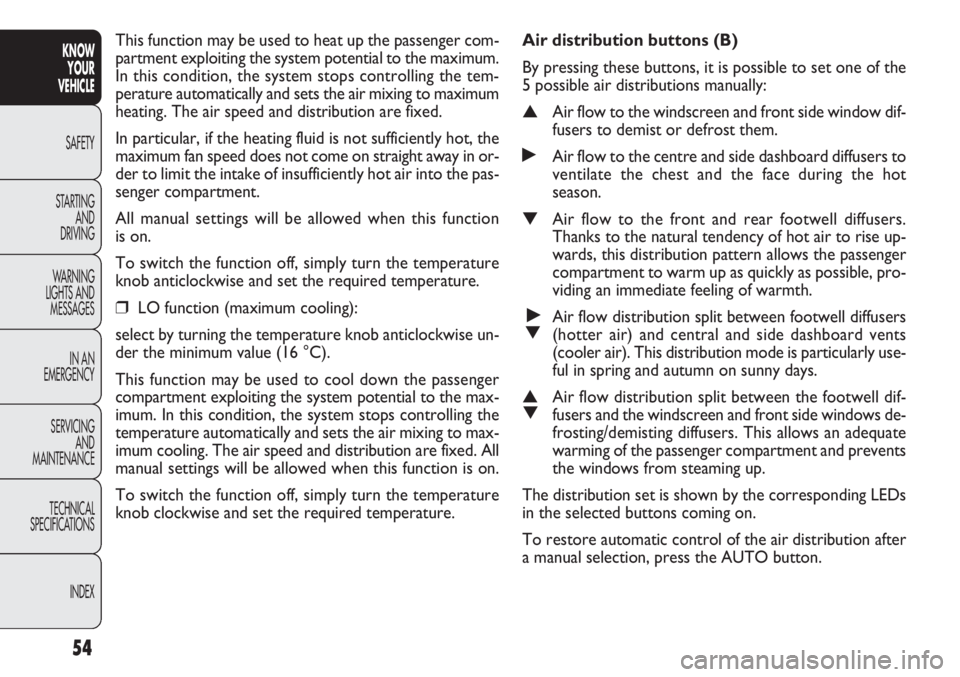
54
KNOWYOUR
VEHICLE
SAFETY
ST AR
TING AND
DRIVING
WARNING
LIGHTS AND MESSAGES
IN AN
EMERGENCY
SERVICING AND
MAINTENANCE
TECHNICAL
SPECIFICATIONS
INDEX
Air distribution buttons (B)
By pressing these buttons, it is possible to set one of the
5 possible air distributions manually:
▲Air flow to the windscreen and front side window dif-
fusers to demist or defrost them.
˙Air flow to the centre and side dashboard diffusers to
ventilate the chest and the face during the hot
season.
▼Air flow to the front and rear footwell diffusers.
Thanks to the natural tendency of hot air to rise up-
wards, this distribution pattern allows the passenger
compartment to warm up as quickly as possible, pro-
viding an immediate feeling of warmth.
˙
▼Air flow distribution split between footwell diffusers
(hotter air) and central and side dashboard vents
(cooler air). This distribution mode is particularly use-
ful in spring and autumn on sunny days.
▲ ▼Air flow distribution split between the footwell dif-
fusers and the windscreen and front side windows de-
frosting/demisting diffusers. This allows an adequate
warming of the passenger compartment and prevents
the windows from steaming up.
The distribution set is shown by the corresponding LEDs
in the selected buttons coming on.
To restore automatic control of the air distribution after
a manual selection, press the AUTO button.
This function may be used to heat up the passenger com-
partment exploiting the system potential to the maximum.
In this condition, the system stops controlling the tem-
perature automatically and sets the air mixing to maximum
heating. The air speed and distribution are fixed.
In particular, if the heating fluid is not sufficiently hot, the
maximum fan speed does not come on straight away in or-
der to limit the intake of insufficiently hot air into the pas-
senger compartment.
All manual settings will be allowed when this function
is on.
To switch the function off, simply turn the temperature
knob anticlockwise and set the required temperature.
❒LO function (maximum cooling):
select by turning the temperature knob anticlockwise un-
der the minimum value (16 °C).
This function may be used to cool down the passenger
compartment exploiting the system potential to the max-
imum. In this condition, the system stops controlling the
temperature automatically and sets the air mixing to max-
imum cooling. The air speed and distribution are fixed. All
manual settings will be allowed when this function is on.
To switch the function off, simply turn the temperature
knob clockwise and set the required temperature.
Page 59 of 283
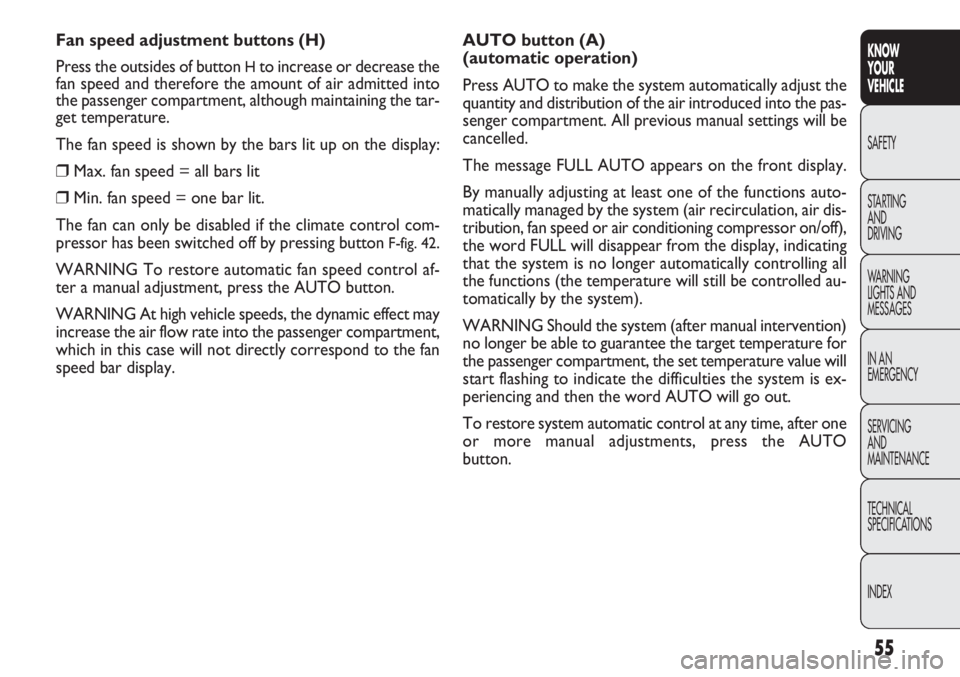
55
KNOW
YOUR
VEHICLE
SAFETY
STAR
TING
AND
DRIVING
WARNING
LIGHTS AND
MESSAGES
IN AN
EMERGENCY
SERVICING
AND
MAINTENANCE
TECHNICAL
SPECIFICATIONS
INDEX
AUTO button (A)
(automatic operation)
Press AUTO to make the system automatically adjust the
quantity and distribution of the air introduced into the pas-
senger compartment. All previous manual settings will be
cancelled.
The message FULL AUTO appears on the front display.
By manually adjusting at least one of the functions auto-
matically managed by the system (air recirculation, air dis-
tribution, fan speed or air conditioning compressor on/off),
the word FULL will disappear from the display, indicating
that the system is no longer automatically controlling all
the functions (the temperature will still be controlled au-
tomatically by the system).
WARNING Should the system (after manual intervention)
no longer be able to guarantee the target temperature for
the passenger compartment, the set temperature value will
start flashing to indicate the difficulties the system is ex-
periencing and then the word AUTO will go out.
To restore system automatic control at any time, after one
or more manual adjustments, press the AUTO
button.
Fan speed adjustment buttons (H)
Press the outsides of button
Hto increase or decrease the
fan speed and therefore the amount of air admitted into
the passenger compartment, although maintaining the tar-
get temperature.
The fan speed is shown by the bars lit up on the display:
❒Max. fan speed = all bars lit
❒Min. fan speed = one bar lit.
The fan can only be disabled if the climate control com-
pressor has been switched off by pressing button
F-fig. 42.
WARNING To restore automatic fan speed control af-
ter a manual adjustment, press the AUTO button.
WARNING At high vehicle speeds, the dynamic effect may
increase the air flow rate into the passenger compartment,
which in this case will not directly correspond to the fan
speed bar display.
Page 60 of 283
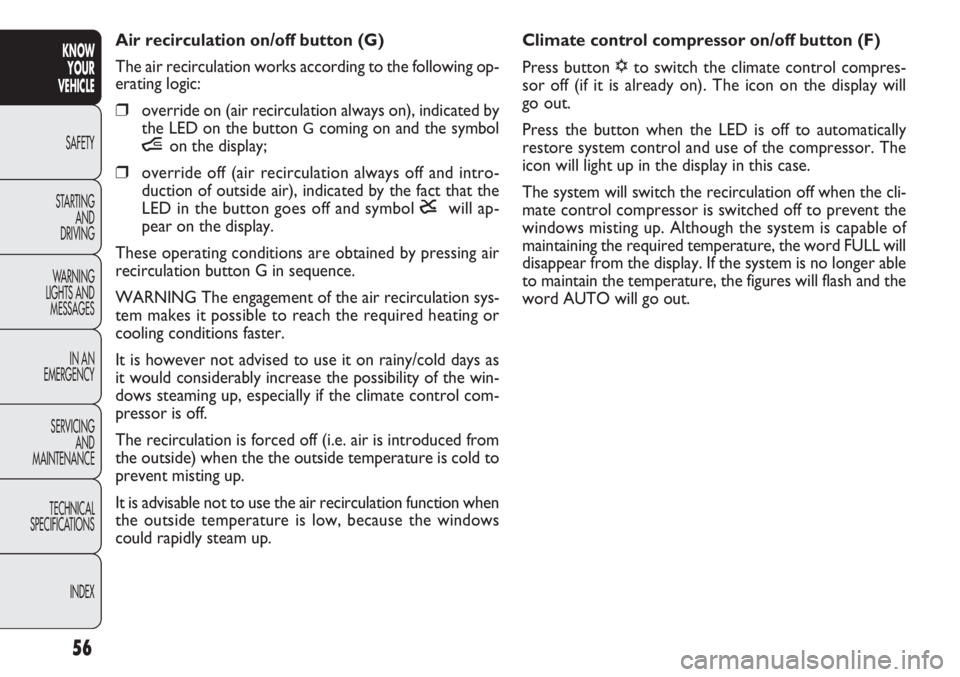
56
KNOWYOUR
VEHICLE
SAFETY
ST AR
TING AND
DRIVING
WARNING
LIGHTS AND MESSAGES
IN AN
EMERGENCY
SERVICING AND
MAINTENANCE
TECHNICAL
SPECIFICATIONS
INDEX
Climate control compressor on/off button (F)
Press button √to switch the climate control compres-
sor off (if it is already on). The icon on the display will
go out.
Press the button when the LED is off to automatically
restore system control and use of the compressor. The
icon will light up in the display in this case.
The system will switch the recirculation off when the cli-
mate control compressor is switched off to prevent the
windows misting up. Although the system is capable of
maintaining the required temperature, the word FULL will
disappear from the display. If the system is no longer able
to maintain the temperature, the figures will flash and the
word AUTO will go out.
Air recirculation on/off button (G)
The air recirculation works according to the following op-
erating logic:
❒override on (air recirculation always on), indicated by
the LED on the button
Gcoming on and the symbol
í on the display;
❒override off (air recirculation always off and intro-
duction of outside air), indicated by the fact that the
LED in the button goes off and symbol ê will ap-
pear on the display.
These operating conditions are obtained by pressing air
recirculation button G in sequence.
WARNING The engagement of the air recirculation sys-
tem makes it possible to reach the required heating or
cooling conditions faster.
It is however not advised to use it on rainy/cold days as
it would considerably increase the possibility of the win-
dows steaming up, especially if the climate control com-
pressor is off.
The recirculation is forced off (i.e. air is introduced from
the outside) when the the outside temperature is cold to
prevent misting up.
It is advisable not to use the air recirculation function when
the outside temperature is low, because the windows
could rapidly steam up.
Page 61 of 283
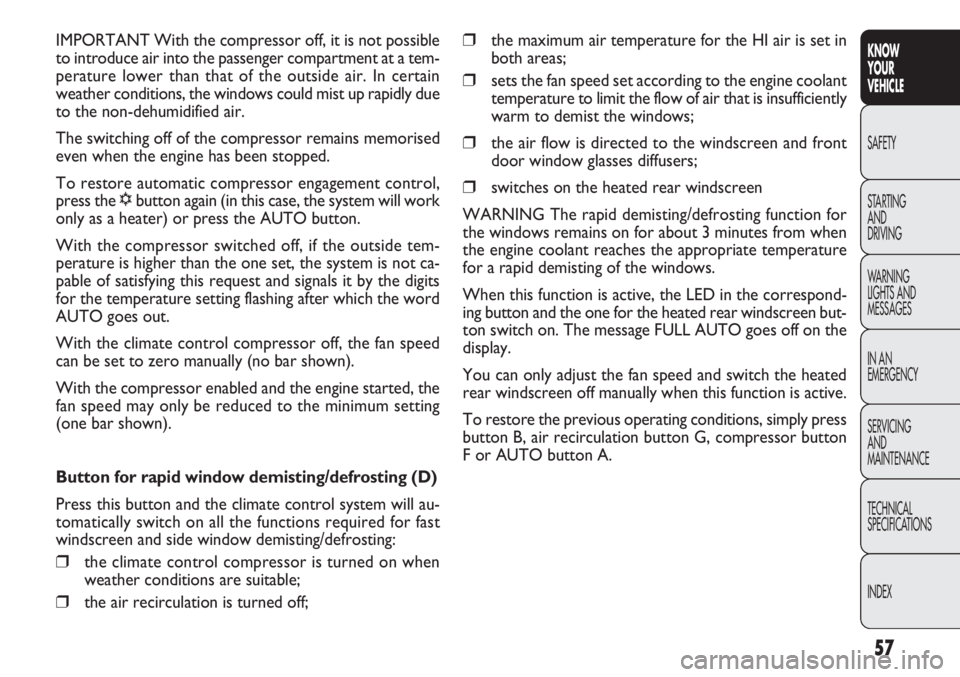
57
KNOW
YOUR
VEHICLE
SAFETY
STAR
TING
AND
DRIVING
WARNING
LIGHTS AND
MESSAGES
IN AN
EMERGENCY
SERVICING
AND
MAINTENANCE
TECHNICAL
SPECIFICATIONS
INDEX
❒the maximum air temperature for the HI air is set in
both areas;
❒sets the fan speed set according to the engine coolant
temperature to limit the flow of air that is insufficiently
warm to demist the windows;
❒the air flow is directed to the windscreen and front
door window glasses diffusers;
❒switches on the heated rear windscreen
WARNING The rapid demisting/defrosting function for
the windows remains on for about 3 minutes from when
the engine coolant reaches the appropriate temperature
for a rapid demisting of the windows.
When this function is active, the LED in the correspond-
ing button and the one for the heated rear windscreen but-
ton switch on. The message FULL AUTO goes off on the
display.
You can only adjust the fan speed and switch the heated
rear windscreen off manually when this function is active.
To restore the previous operating conditions, simply press
button B, air recirculation button G, compressor button
F or AUTO button A.
IMPORTANT With the compressor off, it is not possible
to introduce air into the passenger compartment at a tem-
perature lower than that of the outside air. In certain
weather conditions, the windows could mist up rapidly due
to the non-dehumidified air.
The switching off of the compressor remains memorised
even when the engine has been stopped.
To restore automatic compressor engagement control,
press the √
button again (in this case, the system will work
only as a heater) or press the AUTO button.
With the compressor switched off, if the outside tem-
perature is higher than the one set, the system is not ca-
pable of satisfying this request and signals it by the digits
for the temperature setting flashing after which the word
AUTO goes out.
With the climate control compressor off, the fan speed
can be set to zero manually (no bar shown).
With the compressor enabled and the engine started, the
fan speed may only be reduced to the minimum setting
(one bar shown).
Button for rapid window demisting/defrosting (D)
Press this button and the climate control system will au-
tomatically switch on all the functions required for fast
windscreen and side window demisting/defrosting:
❒the climate control compressor is turned on when
weather conditions are suitable;
❒the air recirculation is turned off;
Page 62 of 283
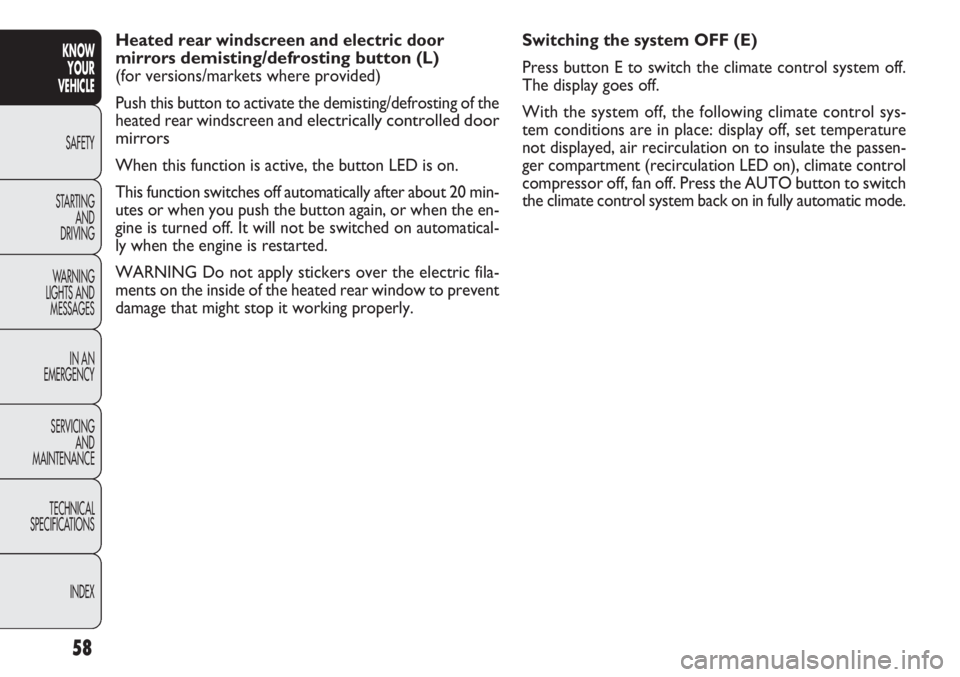
58
KNOWYOUR
VEHICLE
SAFETY
ST AR
TING AND
DRIVING
WARNING
LIGHTS AND MESSAGES
IN AN
EMERGENCY
SERVICING AND
MAINTENANCE
TECHNICAL
SPECIFICATIONS
INDEX
Switching the system OFF (E)
Press button E to switch the climate control system off.
The display goes off.
With the system off, the following climate control sys-
tem conditions are in place: display off, set temperature
not displayed, air recirculation on to insulate the passen-
ger compartment (recirculation LED on), climate control
compressor off, fan off. Press the AUTO button to switch
the climate control system back on in fully automatic mode.
Heated rear windscreen and electric door
mirrors
demisting/defrosting button(L)
(for versions/markets where provided)
Push this button to activate the demisting/defrosting of the
heated rear windscreen
and electrically controlled door
mirrors
When this function is active, the button LED is on.
This function switches off automatically after about 20 min-
utes or when you push the button again, or when the en-
gine is turned off. It will not be switched on automatical-
ly when the engine is restarted.
WARNING Do not apply stickers over the electric fila-
ments on the inside of the heated rear window to prevent
damage that might stop it working properly.
Page 63 of 283
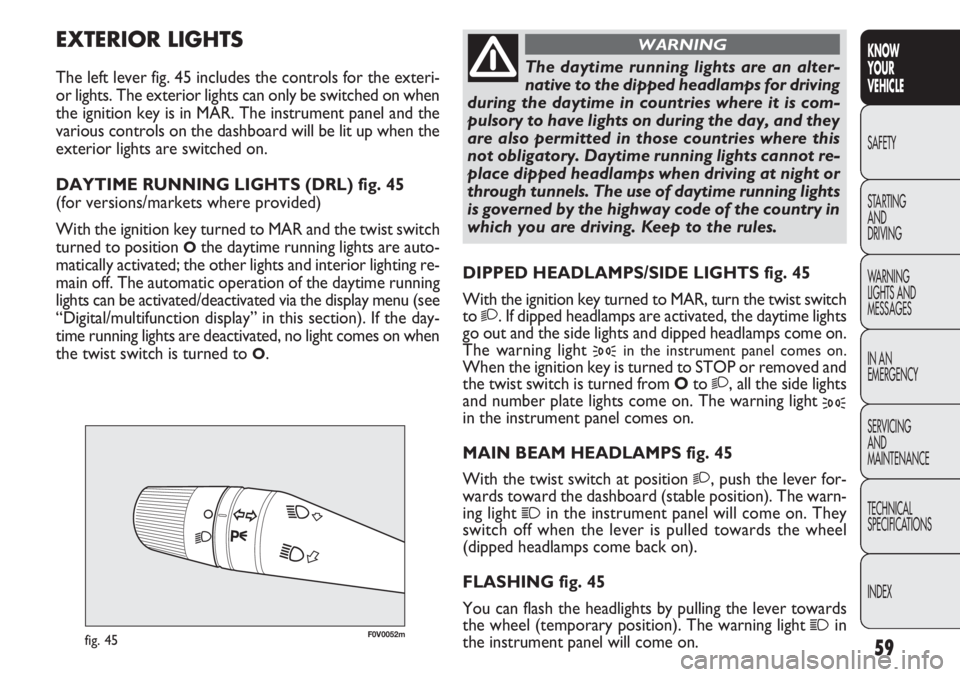
59
KNOW
YOUR
VEHICLE
SAFETY
STAR
TING
AND
DRIVING
WARNING
LIGHTS AND
MESSAGES
IN AN
EMERGENCY
SERVICING
AND
MAINTENANCE
TECHNICAL
SPECIFICATIONS
INDEX
F0V0052mfig. 45
DIPPED HEADLAMPS/SIDE LIGHTS fig. 45
With the ignition key turned to MAR, turn the twist switch
to
2. If dipped headlamps are activated, the daytime lights
go out and the side lights and dipped headlamps come on.
The warning light
3in the instrument panel comes on.
When the ignition key is turned to STOP or removed and
the twist switch is turned from O to
2, all the side lights
and number plate lights come on. The warning light
3in the instrument panel comes on.
MAIN BEAM HEADLAMPS fig. 45
With the twist switch at position
2, push the lever for-
wards toward the dashboard (stable position). The warn-
ing light
1in the instrument panel will come on. They
switch off when the lever is pulled towards the wheel
(dipped headlamps come back on).
FLASHING fig. 45
You can flash the headlights by pulling the lever towards
the wheel (temporary position). The warning light
1in
the instrument panel will come on.
EXTERIOR LIGHTS
The left lever fig. 45 includes the controls for the exteri-
or lights. The exterior lights can only be switched on when
the ignition key is in MAR. The instrument panel and the
various controls on the dashboard will be lit up when the
exterior lights are switched on.
DAYTIME RUNNING LIGHTS (DRL) fig. 45
(for versions/markets where provided)
With the ignition key turned to MAR and the twist switch
turned to position
Othe daytime running lights are auto-
matically activated; the other lights and interior lighting re-
main off. The automatic operation of the daytime running
lights can be activated/deactivated via the display menu (see
“Digital/multifunction display” in this section). If the day-
time running lights are deactivated, no light comes on when
the twist switch is turned to
O.
The daytime running lights are an alter-
native to the dipped headlamps for driving
during the daytime in countries where it is com-
pulsory to have lights on during the day, and they
are also permitted in those countries where this
not obligatory. Daytime running lights cannot re-
place dipped headlamps when driving at night or
through tunnels. The use of daytime running lights
is governed by the highway code of the country in
which you are driving. Keep to the rules.
WARNING
Page 64 of 283
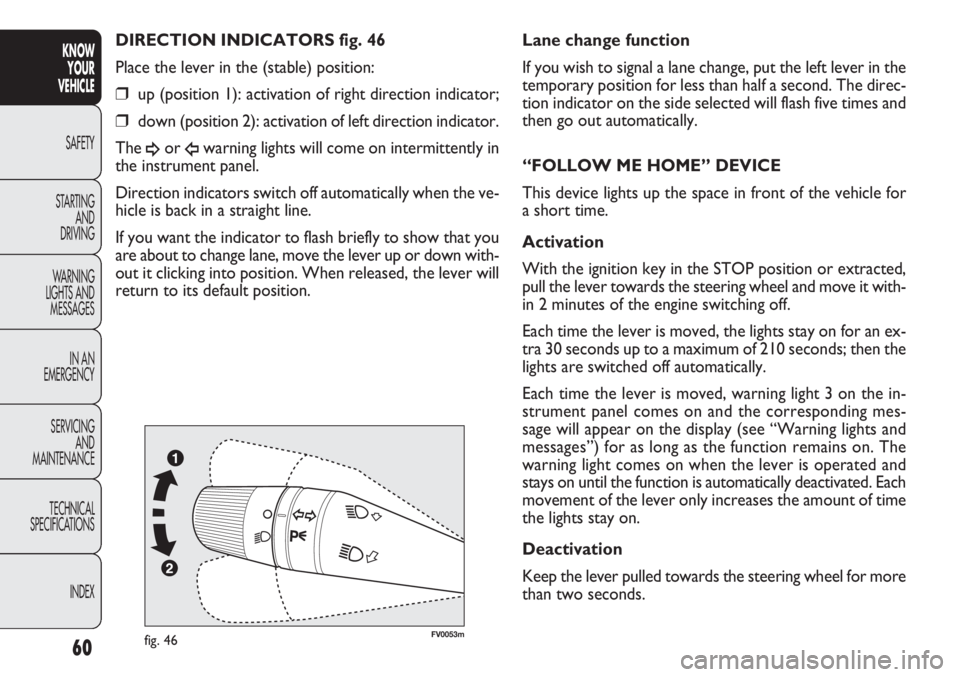
60
KNOWYOUR
VEHICLE
SAFETY
ST AR
TING AND
DRIVING
WARNING
LIGHTS AND MESSAGES
IN AN
EMERGENCY
SERVICING AND
MAINTENANCE
TECHNICAL
SPECIFICATIONS
INDEX
FV0053mfig. 46
Lane change function
If you wish to signal a lane change, put the left lever in the
temporary position for less than half a second. The direc-
tion indicator on the side selected will flash five times and
then go out automatically.
“FOLLOW ME HOME” DEVICE
This device lights up the space in front of the vehicle for
a short time.
Activation
With the ignition key in the STOP position or extracted,
pull the lever towards the steering wheel and move it with-
in 2 minutes of the engine switching off.
Each time the lever is moved, the lights stay on for an ex-
tra 30 seconds up to a maximum of 210 seconds; then the
lights are switched off automatically.
Each time the lever is moved, warning light 3 on the in-
strument panel comes on and the corresponding mes-
sage will appear on the display (see “Warning lights and
messages”) for as long as the function remains on. The
warning light comes on when the lever is operated and
stays on until the function is automatically deactivated. Each
movement of the lever only increases the amount of time
the lights stay on.
Deactivation
Keep the lever pulled towards the steering wheel for more
than two seconds.
DIRECTION INDICATORS fig. 46
Place the lever in the (stable) position:
❒up (position 1): activation of right direction indicator;
❒down (position 2): activation of left direction indicator.
The
¥or Îwarning lights will come on intermittently in
the instrument panel.
Direction indicators switch off automatically when the ve-
hicle is back in a straight line.
If you want the indicator to flash briefly to show that you
are about to change lane, move the lever up or down with-
out it clicking into position. When released, the lever will
return to its default position.
Page 65 of 283
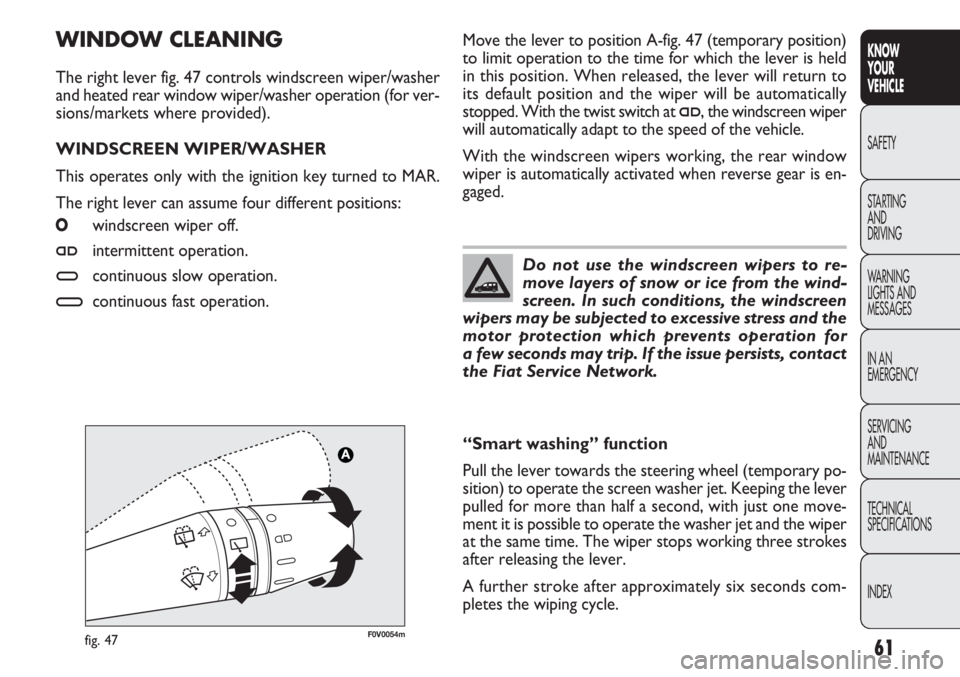
61
KNOW
YOUR
VEHICLE
SAFETY
STAR
TING
AND
DRIVING
WARNING
LIGHTS AND
MESSAGES
IN AN
EMERGENCY
SERVICING
AND
MAINTENANCE
TECHNICAL
SPECIFICATIONS
INDEX
Move the lever to position A-fig. 47 (temporary position)
to limit operation to the time for which the lever is held
in this position. When released, the lever will return to
its default position and the wiper will be automatically
stopped. With the twist switch at
≤, the windscreen wiper
will automatically adapt to the speed of the vehicle.
With the windscreen wipers working, the rear window
wiper is automatically activated when reverse gear is en-
gaged.
WINDOW CLEANING
The right lever fig. 47 controls windscreen wiper/washer
and heated rear window wiper/washer operation (for ver-
sions/markets where provided).
WINDSCREEN WIPER/WASHER
This operates only with the ignition key turned to MAR.
The right lever can assume four different positions:
Owindscreen wiper off.
≤intermittent operation.
≥continuous slow operation.
¥continuous fast operation.
Do not use the windscreen wipers to re-
move layers of snow or ice from the wind-
screen. In such conditions, the windscreen
wipers may be subjected to excessive stress and the
motor protection which prevents operation for
a few seconds may trip. If the issue persists, contact
the Fiat Service Network.
“Smart washing” function
Pull the lever towards the steering wheel (temporary po-
sition) to operate the screen washer jet. Keeping the lever
pulled for more than half a second, with just one move-
ment it is possible to operate the washer jet and the wiper
at the same time. The wiper stops working three strokes
after releasing the lever.
A further stroke after approximately six seconds com-
pletes the wiping cycle.
F0V0054mfig. 47
Page 66 of 283
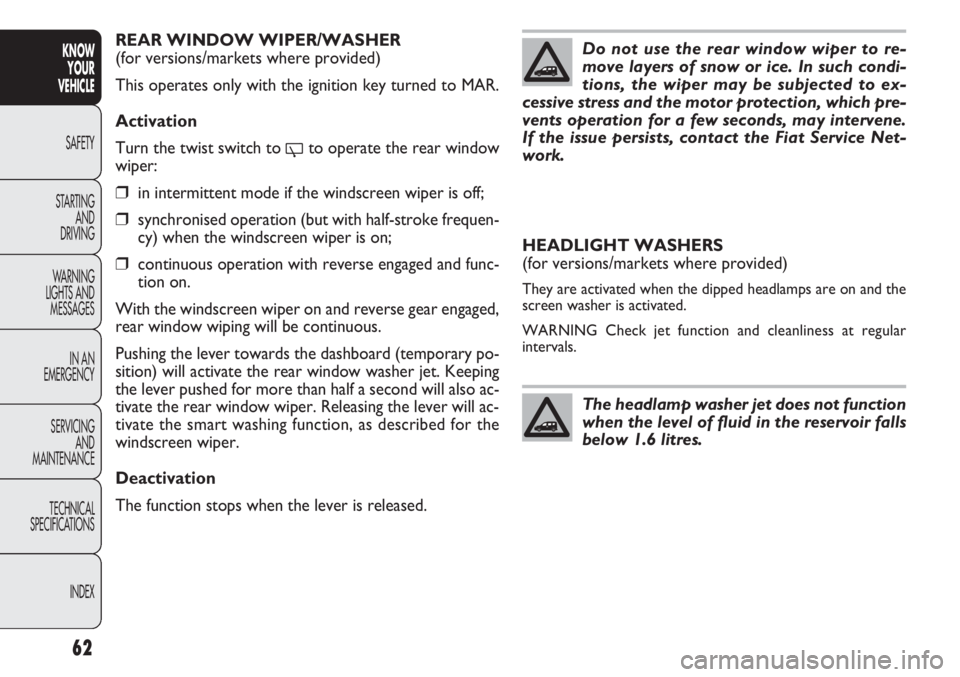
62
KNOWYOUR
VEHICLE
SAFETY
ST AR
TING AND
DRIVING
WARNING
LIGHTS AND MESSAGES
IN AN
EMERGENCY
SERVICING AND
MAINTENANCE
TECHNICAL
SPECIFICATIONS
INDEX
REAR WINDOW WIPER/WASHER
(for versions/markets where provided)
This operates only with the ignition key turned to MAR.
Activation
Turn the twist switch to
'to operate the rear window
wiper:
❒in intermittent mode if the windscreen wiper is off;
❒synchronised operation (but with half-stroke frequen-
cy) when the windscreen wiper is on;
❒continuous operation with reverse engaged and func-
tion on.
With the windscreen wiper on and reverse gear engaged,
rear window wiping will be continuous.
Pushing the lever towards the dashboard (temporary po-
sition) will activate the rear window washer jet. Keeping
the lever pushed for more than half a second will also ac-
tivate the rear window wiper. Releasing the lever will ac-
tivate the smart washing function, as described for the
windscreen wiper.
Deactivation
The function stops when the lever is released.
Do not use the rear window wiper to re-
move layers of snow or ice. In such condi-
tions, the wiper may be subjected to ex-
cessive stress and the motor protection, which pre-
vents operation for a few seconds, may intervene.
If the issue persists, contact the Fiat Service Net-
work.
HEADLIGHT WASHERS
(for versions/markets where provided)
They are activated when the dipped headlamps are on and the
screen washer is activated.
WARNING Check jet function and cleanliness at regular
intervals.
The headlamp washer jet does not function
when the level of fluid in the reservoir falls
below 1.6 litres.